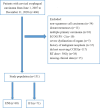Elective nodal irradiation versus involved-field irradiation for stage II-IV cervical esophageal squamous cell carcinoma patients undergoing definitive concurrent chemoradiotherapy: a retrospective propensity study with 8-year survival outcomes
- PMID: 37641149
- PMCID: PMC10464095
- DOI: 10.1186/s13014-023-02332-2
Elective nodal irradiation versus involved-field irradiation for stage II-IV cervical esophageal squamous cell carcinoma patients undergoing definitive concurrent chemoradiotherapy: a retrospective propensity study with 8-year survival outcomes
Abstract
Background: Definitive concurrent chemoradiotherapy (dCCRT) is suggested as the standard treatment for cervical esophageal squamous cell carcinoma (CESCC). This retrospective propensity study compared the 8-year survival outcomes and acute treatment toxicities of these patients treated with elective nodal irradiation (ENI) versus involved-field irradiation (IFI).
Materials and methods: Patients with stage II-IV CESCC treated with dCCRT at the Fourth Hospital of Hebei Medical University between January 1, 2007 and December 31, 2020 were enrolled in the study. All the patients were restaged according to the American Joint Commission 8th edition criteria. The propensity score matching (PSM) was used to minimize the effects of treatment selection bias and potential confounding factors including sex, age, ECOG score, clinical T stage, clinical N stage, clinical TNM stage and radiation dose between the ENI group and IFI group. Survival and the prognostic factors were evaluated.
Results: The 131 eligible patients underwent ENI (60 patients, 45.8%) or IFI (71 patients, 54.2%). The median follow-up time was 91.1 months (range, 23.8-182.0 months) for all the patients. The median OS, 1-, 3-, 5-, and 8-year OS rates were 44.4 months, 87.8%, 55.1%, 38.3%, and 27.2%, respectively. After PSM, there were 49 patients in each group. The median OS, 1-, 3-, 5-, and 8-year OS rates for ENI and IFI group were 32.0 months, 83.7%, 48.5%, 38.5% and 31.1% versus 45.2 months, 89.8%, 52.5%, 37.5%, 26.1%, respectively (P = 0.966; HR 0.99, 95% CI 0.61-1.61). Similar locoregional control was obtained in both groups. The tendency of leukocytopenia and neutropenia was higher in ENI than in IFI (59.2% vs. 38.8%; P = 0.068 and 30.6% vs. 14.3%; P = 0.089) at the end of dCCRT.
Conclusion: Cervical esophageal squamous cell carcinoma patients undergoing definitive concurrent chemoradiotherapy has a satisfactory prognosis with organ conservation. The involved-field irradiation might be a better alternative owing to similar overall survival outcomes and local control with less toxicity of myelosuppression.
Keywords: Cervical esophagus; Elective nodal irradiation; Involved-field irradiation; Squamous cell carcinoma; Survival.
© 2023. BioMed Central Ltd., part of Springer Nature.
Conflict of interest statement
The authors declare no competing interests.
Figures
Similar articles
-
Elective nodal irradiation or involved-field irradiation in definitive chemoradiotherapy for esophageal squamous cell cancer: a retrospective analysis in clinical N0 patients.Curr Oncol. 2018 Oct;25(5):e423-e429. doi: 10.3747/co.25.3895. Epub 2018 Oct 31. Curr Oncol. 2018. PMID: 30464693 Free PMC article.
-
Elective nodal irradiation provides a superior therapeutic modality for lymph node positivity esophageal squamous cell carcinoma patients receiving definitive radiotherapy versus involved-field irradiation.Medicine (Baltimore). 2019 Jan;98(3):e14080. doi: 10.1097/MD.0000000000014080. Medicine (Baltimore). 2019. PMID: 30653123 Free PMC article.
-
Concurrent chemoradiotherapyof different radiation doses and different irradiation fields for locally advanced thoracic esophageal squamous cell carcinoma: A randomized, multicenter, phase III clinical trial.Cancer Commun (Lond). 2024 Oct;44(10):1173-1188. doi: 10.1002/cac2.12601. Epub 2024 Aug 19. Cancer Commun (Lond). 2024. PMID: 39161079 Free PMC article. Clinical Trial.
-
The role of involved field irradiation versus elective nodal irradiation in definitive radiotherapy or chemoradiotherapy for esophageal cancer- a systematic review and meta-analysis.Front Oncol. 2022 Nov 2;12:1034656. doi: 10.3389/fonc.2022.1034656. eCollection 2022. Front Oncol. 2022. PMID: 36408184 Free PMC article.
-
Can involved-field irradiation replace elective nodal irradiation in chemoradiotherapy for esophageal cancer? A systematic review and meta-analysis.Onco Targets Ther. 2017 Apr 11;10:2087-2095. doi: 10.2147/OTT.S130285. eCollection 2017. Onco Targets Ther. 2017. PMID: 28442917 Free PMC article. Review.
Cited by
-
Dose escalation in radical radio(chemo)therapy for cervical and upper thoracic esophageal cancer with 3DCRT/IMRT (ChC&UES): a multicenter retrospective study.Radiat Oncol. 2024 Sep 27;19(1):126. doi: 10.1186/s13014-024-02521-7. Radiat Oncol. 2024. PMID: 39334163 Free PMC article.
-
Current status and prospects of diagnosis and treatment for esophageal cancer with supraclavicular lymph node metastasis.Front Oncol. 2024 Oct 11;14:1431507. doi: 10.3389/fonc.2024.1431507. eCollection 2024. Front Oncol. 2024. PMID: 39464710 Free PMC article. Review.
-
Definitive chemo-radiotherapy in cervical oesophageal cancer: a comprehensive review of literature.Rep Pract Oncol Radiother. 2024 Jul 22;29(3):391-408. doi: 10.5603/rpor.100777. eCollection 2024. Rep Pract Oncol Radiother. 2024. PMID: 39144270 Free PMC article. Review.
-
Advances in the treatment of unresectable locally advanced esophageal squamous carcinoma (Review).Mol Clin Oncol. 2025 Apr 3;22(6):50. doi: 10.3892/mco.2025.2845. eCollection 2025 Jun. Mol Clin Oncol. 2025. PMID: 40242367 Free PMC article. Review.
References
-
- Lagergren J, Smyth E, Cunningham D, Lagergren P. Oesophageal cancer. Lancet. 2017;390(1):2383–2396. 10.1016/S0140-6736(17)31462-9. - PubMed
-
- Lyu J, Yisikandaer A, Li T, et al. Comparison between the effects of elective nodal irradiation and involved-field irradiation on long-term survival in thoracic esophageal squamous cell carcinoma patients: a prospective, multicenter, randomized, controlled study in China. Cancer Med. 2020;9(20):7460–8. doi: 10.1002/cam4.3409. - DOI - PMC - PubMed
MeSH terms
Grants and funding
LinkOut - more resources
Full Text Sources
Medical
Miscellaneous



